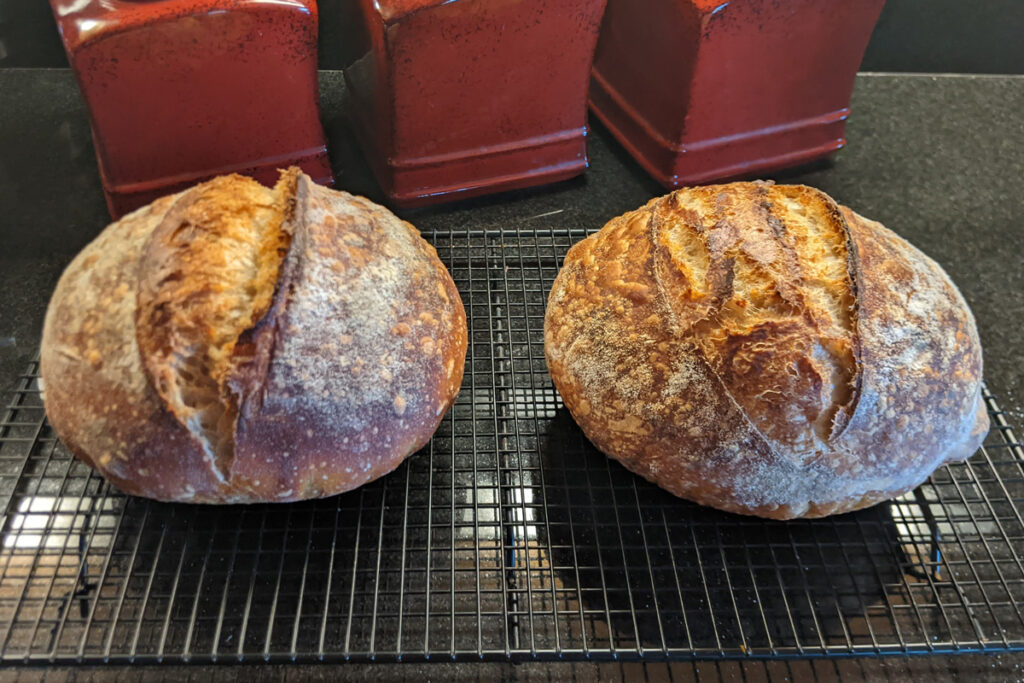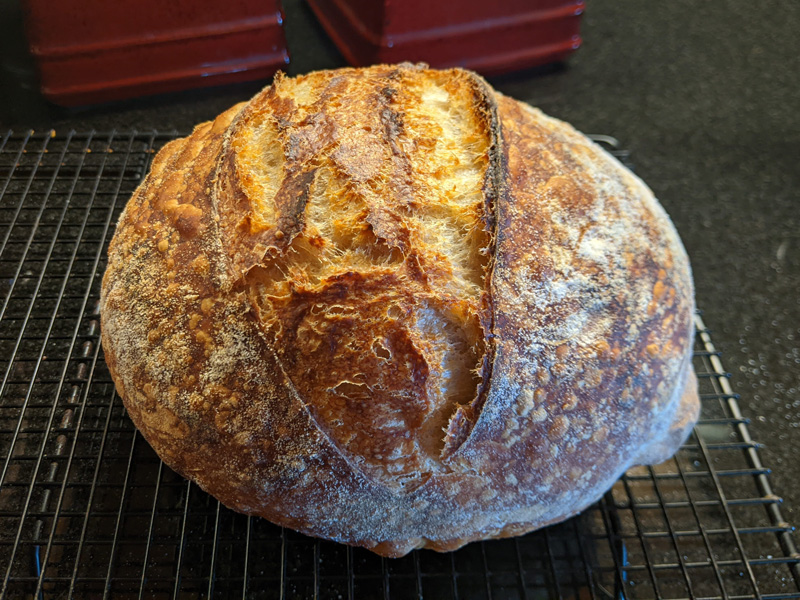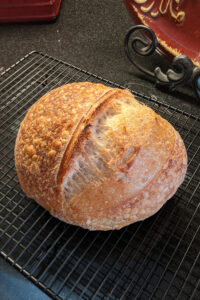It’s been almost two years since I started baking my own bread, among other things. Baking appeals to me, more so than cooking. I think it’s because I see baking as more science than art, whereas cooking is more the opposite.

Baking speaks to my analytical, engineering mind. Each bake is a like a science experiment where I am trying to find the right mix of ingredients. Even the slightest of changes in ingredient ratios can have dramatic effects, which is why I like to measure everything with a scale. The ultimate goal is to find the right mix and ratio of ingredients to create a repeatable process.
As part of my journey baking sourdough bread, I’ve experimented with lots of different variables. My latest experiment involved trying different hydration levels.
What is hydration?
Hydration in sourdough baking is the ratio of the amount of water versus flour in the dough. 100% hydration is equal parts water and flour, which is the hydration level of a classic sourdough starter. 50% hydration has twice as much flour as water, e.g. 100g flour and 50g water. 200% hydration has twice as much water as flour, e.g. 100g water and 50g flour.
When baking sourdough, the level of hydration affects the crumb, texture, and crust of the bread. It also changes how easy, or difficult, it is to work with the bread during the stretching, folding, and shaping process. A low hydration bread is less sticky and easier to shape, while the sticky, gooey consistency of a high hydration bread can be very challenging. At the end of the day, a higher hydration bread will generally have a thinner crust and more open crumb, but it takes more time and patience to work with it.
I’m not going to go into all the details of hydration, but if you’re interested in learning more, there is a good article about hydration over at the True Sourdough website.
The recipes
For my hydration experiment, I tried three different hydration levels, 72%, 78%, and 84%. Here are the recipes and the calculated hydration levels.
Recipe #1 – 72% hydration
- 339g flour
- 226g water
- 120g starter (100% hydration)
- 9g salt
Hydration calculation:
- 286g water (226g water + 60g water in starter)
- 399g flour (339g flour + 60g flour in starter)
- 286g / 399g = 72% hydration
Recipe #2 – 78% hydration
- 339g flour
- 250g water
- 120g starter
- 9g salt
Hydration calculation:
- 310g water (250g water + 60g water in starter)
- 399g flour (339g flour + 60g flour in starter)
- 310g/399g = 78% hydration
Recipe #3 – 84% hydration
- 339g flour
- 275g water
- 120g starter
- 9g salt
Hydration calculation
- 335g water (275g water + 60g water in starter)
- 399g flour (339g flour + 60g flour in starter)
- 335g/399g = 84% hydration
The results
To begin with, each recipe yielded a loaf that tasted great. In my opinion, you can’t go wrong with any of the recipes.
The low hydration recipe of 72% was easier to work with during fermentation, shaping and folding. The dough is easy to handle from the first fold, and it starts holding its shape immediately. On baking, it splits open with a nice baker’s ear. The finished product has a thick crust and somewhat dense inside. It has a chewier texture, the crisp softens quickly.
The mid-hydration recipe of 78% start to get a little more challenging to work with during the folding and shaping process. The first fold can be a little messy, but the dough starts to firm and hold its shape during the second and third folds. The loaf splits open nicely on bake, but not quite as wide as the low hydration loaf. The crumb also tends to be a bit more open, the texture softer, and the crust thinner.

The high hydration recipe of 84% takes time and patience. The dough is very sticky and soft during the first two folds. The loaf doesn’t start to hold its shape until the third fold. Even when doing the final shaping in preparation for overnight fermentation, the dough is soft and struggles to hold its shape. The reward is in the finished product. While the split tends to be deep rather than wide, the crust is the thinnest of the three, and the texture the softest. If that’s what you prefer in your bread, it’s worth the effort.

My thoughts on hydration
As far as taste goes, there is little to no difference in the three hydration levels. They all taste great. The difference is more in texture and look. What you like best will determine the hydration level you choose. The other factor to consider is handling. If you prefer less mess and easier handling, then lower hydration will work better.
For me, I find the middle of the road to work best. I like the thinner crust and softer texture, but I don’t like struggling with the handling. 78% seems to be a good trade-off where I can get the benefits of a higher hydration without struggling with the stretch, fold, and shaping process.
So at the end of the day, my advice is to do what works best for you taking into account preparation, handling, shaping, look, and, most importantly, taste. Don’t listen to what anyone else tells you is the “right” way to do it. There is no “right” way, there is only your way.

